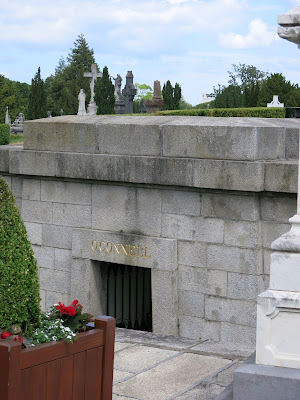More history
While we were in Dublin, we visited the extraordinary Glasnevin Cemetery, where there are more people buried than are above ground in the modern day city - 1.5 million vs. 1.3 million. We started our tour with a visit to the grave of Jeremiah O'Donovan Rossa.
Again from Wikipedia:
O'Donovan Rossa, a founding member of the Irish Republican Brotherhood (popularly known as the Fenians), died in New York on 29 June 1915, aged 84. Another Fenian leader, John Devoy, cabled Tom Clarke in Dublin to ask what should be done. Clarke replied, "Send his body home at once." Clarke and Thomas MacDonaghbegan planning a huge funeral as a demonstration of support for Irish independence.
Clarke chose Patrick Pearse, a barrister and schoolteacher who was known as the foremost orator of the time, to give the graveside oration. At that time republican leaders were refraining from making inflammatory speeches for fear of imprisonment at a crucial time in the preparations for a rising. When Pearse asked how far he should go, Clarke answered, "Make it hot as hell, throw discretion to the winds."[1]
On arrival in Dublin, Rossa's remains were taken to the Pro-Cathedral and lay before the High Altar for one night, with a guard of Irish Volunteers. They then lay in state in City Hall, Dublin, again with a guard of honour, until the funeral. Thousands of Volunteers followed the hearse to Glasnevin Cemetery and hundreds of thousands lined the route.
On arrival in Dublin, Rossa's remains were taken to the Pro-Cathedral and lay before the High Altar for one night, with a guard of Irish Volunteers. They then lay in state in City Hall, Dublin, again with a guard of honour, until the funeral. Thousands of Volunteers followed the hearse to Glasnevin Cemetery and hundreds of thousands lined the route.
Following the interment, Pearse delivered his oration. He spoke "on behalf of a new generation that has been re-baptised in the Fenian faith" and called on the Irish people to stand together for the achievement of the freedom of Ireland. And, he said, "we know only one definition of freedom: it is Tone's definition, it is Mitchel's definition, it is Rossa's definition" (that is, an Irish Republic). The tone of the oration made it very clear that an attempt would soon be made to establish an Irish Republic by force of arms. The oration concluded with a challenge to the "Defenders of this Realm":
We were treated to a well-acted, impassioned reenactment of the oration by a member of the Glasnevin staff, in the uniform of the para-military group of which Pearse was a member. I think Carol spoke for us all when she said she was ready to enlist in the struggle.
Click here to read a copy of the oration by Padraic Pearse.
One extraordinary aspect of our visit was our tour guide, a young, very engaging history teacher and masters graduate of UCD - University College Dublin. As he set the scene for us - the immense crowd, the political tension, the oppressive presence of the English authorities, the fact that we were standing in the very place that the crowd did that day, he shared that the solemnity of the event was marked by the playing of a bugle by a 15 year old boy. That boy was his great great grandfather. How cool is that... It always seems that our visits to Ireland are characterized by these moments of unanticipated serendipity.
So much more history in Glasnevin - the grave of the Great Liberator, Daniel O'Connell whose "monster meetings" drew as many as 250,000 people as the Catholics of Ireland strived to regain the rights lost to the "Penal Laws," and the burial site of Michael Collins, the tragic sacrifice offered up on the march toward complete freedom for Ireland.
 |
| Miscellaneous crypt |
 |
| At the grave of O'Donovan Rossa |
 |
| The Great Liberator |
 |
| Inside O'Connell's crypt, under the round tower memorial |
 |
| One of the most important figures in Irish Independence Eamon de Valera |
 |
| The grave of Michael Collins, killed during the Irish Civil War for signing the treaty creating the Irish Free State, a compromise that many found unacceptable |
 |
| The round tower memorial over the grave of Daniel O'Connell |